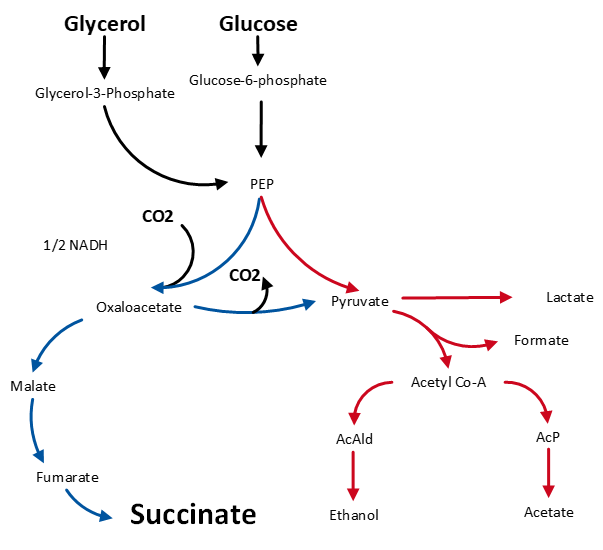(318b) Empowering Carbon Negative Bio-Chemicals with Advanced Electrochemical Separations
AIChE Annual Meeting
2022
2022 Annual Meeting
Forest and Plant Bioproducts Division
Advanced Separations Processes in Bioprocessing and Biomaterials
Tuesday, November 15, 2022 - 12:45pm to 1:00pm
However, efficient downstream technologies with low process carbon footprints are necessary to preserve the carbon capture capacity of bio-succinic acid production. In contrast, most techno economic studies recommend to focus on the development of aerobic and low pH tolerant yeast strains.4 A low pH fermentation reduces the complexity of the downstream processing at the expense of CO2 emissions from the up-stream. The newly emerging electrochemical separation technologies5–9 allow a waste free separation of succinic acid. We compared the state of the art downstream technologies for succinic acid purification with in situ separation by electrochemical pH swing extraction. First, we investigate the thermodynamic limits of the microbial metabolism in prokaryotic and eukaryotic host cells and identify a tradeoff between microbial energy demand for product export under low pH conditions and high carbon conversion yields which require a neutral pH in the fermentation. Second, we quantify the effect of these limits on a process scale by comparing different conceptual process designs for succinic acid purification in an extension of a previous techno economic assessment. The electrochemical pH swing separation revealed the potential to maintain the negative carbon emission balance for succinic acid production, while also reducing the water consumption and waste footprint in comparison to the state of the art technologies.10 Finally, we implemented a dynamic process model in MATLAB to validate the feasibility of in situ product removal by electrochemical pH swing extraction and electrochemical pH control of a dual substrate (glycerol and CO2) succinic acid fermentation.11 In a sensitivity analysis we compared the reaction kinetic of the fermentation with the kinetics of a pH swing electrolysis with integrated reactive extraction of succinic acid by tertiary amines. The sensitivity study shows that the electrolysis is the rate limiting step for product recovery but significantly faster than the production rate of the fermentation, thus making electrochemical pH-control feasible. We applied the dynamic model to investigate the potential to operate the succinic acid production with a closed base recycle loop. The results show that if concentrated feedstock is available, the consumption of pH control agent in the fermentation is reduced by 88% and the fresh water demand can be reduced by 99% compared to the open loop process.11 The electrification of succinic acid downstream processing, when operated with renewable electricity, turns bio-succinic acid into a carbons sink for other industries and thereby provides a promising perspective for industrial carbon integration.
Literature Cited
1. Hsu K-H, Chen C-W, Wang L-Y, Chan H-W, He C-L, Cho C-J, Rwei S-P, Kuo C-C. Bio-based thermoplastic poly(butylene succinate-co-propylene succinate) copolyesters: effect of glycerol on thermal and mechanical properties. Soft matter. 2019;15(47):9710–9720.
2. Patel MK, Crank M, Dornburg V, Hermann B, Roes L. Medium and Long-term Opportunities and Risks of the Biotechnological Production of Bulk Chemicals from Renewable Resources., 2006.
3. Dessie W, Wang Z, Luo X, Wang M, Qin Z. Insights on the Advancements of In Silico Metabolic Studies of Succinic Acid Producing Microorganisms: A Review with Emphasis on Actinobacillus succinogenes. Fermentation. 2021;7(4):220.
4. Dickson R, Mancini E, Garg N, Woodley JM, Gernaey KV, Pinelo M, Liu J, Mansouri SS. Sustainable bio-succinic acid production: superstructure optimization, techno-economic, and lifecycle assessment. Energy Environ. Sci. 2021;14(6):3542–3558.
5. Handojo L, Wardani AK, Regina D, Bella C, Kresnowati MTAP, Wenten IG. Electro-membrane processes for organic acid recovery. RSC Adv. 2019;9(14):7854–7869.
6. Pateraki C, Andersen SJ, Ladakis D, Koutinas A, Rabaey K. Direct electrochemical extraction increases microbial succinic acid production from spent sulphite liquor. Green Chem. 2019;21(9):2401–2411.
7. Gausmann M, Kocks C, Doeker M, Eggert A, Maßmann T, Jupke A. Recovery of succinic acid by integrated multi-phase electrochemical pH-shift extraction and crystallization. Separation and Purification Technology. 2020;240(240):116489.
8. Gausmann M, Kocks C, Pastoors J, Büchs J, Wierckx N, Jupke A. Electrochemical pH-T-Swing Separation of Itaconic Acid for Zero Salt Waste Downstream Processing. ACS Sustainable Chem. Eng. 2021;9(28):9336–9347.
9. Gausmann M, Gössi A, Bertram F, Riedl W, Schuur B, Jupke A. Electrochemical membrane-assisted pH-swing extraction and back-extraction of lactic acid. Separation and Purification Technology. 2022;289(3):120702.
10. Gausmann M, Jupke A. Techno economic assessment of downstream technologies for carbon negative bio-succinic acid production. Manuscript in preparation. 2022.
11. Gausmann M, Kiefel R, Jupke A. Dynamic modeling of electrochemical pH swing extraction for in situ separation of succinic acid reveals biorefinery integration potential. Manuscript in submission. 2022.
